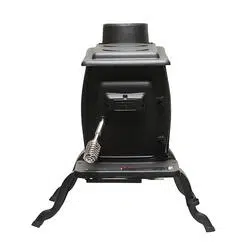Loading ...
Loading ...
Loading ...

-7-
WRONG
RIGHT
FIG. 7
WRONG
FIG. 5
ELBOW
COLLAR
THIMBLE
FLOOR PROTECTOR
FLUE CONNECTION-NON-COMBUSTIBLE WALL
PIPE
NONCOMBUSTIBLE WALL
PIPE
BAROMETRIC
DRAFT REGULATOR
FIG. 6
PIPE REDUCER
FLOOR PROTECTOR
3 FT. MIN.
2 FT. MIN
10 FT.
CHIMNEY CAP MANDATORY
11 FT. MINIMUM
BAROMETRIC
DRAFT REGULATOR
PIPE
NONCOMBUSTIBLE
CONSTRUCTION IN
ACCORDANCE WITH
NFPA 211
Chimney Connection
MASONRY CHIMNEY
The masonry chimney must be code approved and have a ue liner.
The masonry chimney must comply with UL, ULC codes. Before using an
existing masonry chimney, clean the chimney and inspect the ue liner
to be sure it is safe to use. Make repairs before attaching the heater. The
connector pipe and ttings you will need to connect directly to a masonry
chimney are shown. If the connector pipe must go through a combustible
wall before entering the masonry chimney, consult a qualied mason or
chimney dealer. The installation must conform to local re codes, and
NFPA 211(USA) or CAN/CSA-B365-M91 (Canada). Do not connect this
heater into the same chimney ue as the replace or ue from another
heater. The chimney used for a heater must not be used to ventilate
the cellar or basement. If there is a cleanout opening at the base of the
chimney, close it tightly.
UL/ULC LISTED CHIMNEY
Carefully follow the chimney manufacturer's instructions. Use only listed
type HT per UL 103, ULC, 6-in diameter black or blued chimney connector,
minimum 24 gauge steel. If your chimney starts at the ceiling, you will need
enough 6" pipe to reach the ceiling. The top of the chimney must be at
least 3 feet above the roof and be at least 2 feet higher than any point of
the roof within 10 feet. Use double or triple wall pipe for the exterior portion
of the chimney.
RULES FOR CONNECTOR PIPE INSTALLATION
1. The crimped end of the pipe must be installed toward the heater.
The pipe should slide into the ue collar. The pipe should be rmly
attached to the ue collar with 3 screws and sealed with furnace
cement.
2. Slope any horizontal pipe upward toward the chimney at least 1/4" for
each foot of horizontal run. The horizontal section must be a minimum
of 24" from the stove.
3. You must have at least 18" inches clearance between any horizontal
piping and the ceiling.
4. The pipe cannot extend into the chimney ue.
5. Seal each connector pipe joint with furnace cement. Also, seal the
pipe at the chimney. Seal the inside with high-temperature silicone
and the outside with high-temperature tape.
6. Use 3 sheet metal screws at each joint to make the piping rigid.
7. It is recommended that no more than two (2) 90-degree bends be
used in the stove pipe installation as more than two (2) may decrease
the amount of draw and possibly cause smoke spillage.
NOTE: The chimney connector shall not pass through an attic, roof space,
oor, ceiling, or similar concealed space. Where passage through a wall
or partition of combustible construction is desired, the installation must
conform with CAN/CSA - B365.
IMPORTANCE OF PROPER DRAFT
Draft is the force which moves air from the appliance up through the
chimney. The amount of draft in your chimney depends on the length of
the chimney, local geography, nearby obstructions and other factors. Too
much draft may cause excessive temperatures in the appliance and may
damage the catalytic combustor (if equipped). Inadequate draft may
cause backpufng into the room and ‘plugging’ of the chimney or the
catalyst (if equipped). Inadequate draft will cause the appliance to leak
smoke into the room through appliance and chimney connector joints. An
uncontrollable burn or excessive temperature indicates excessive draft.
Loading ...
Loading ...
Loading ...
